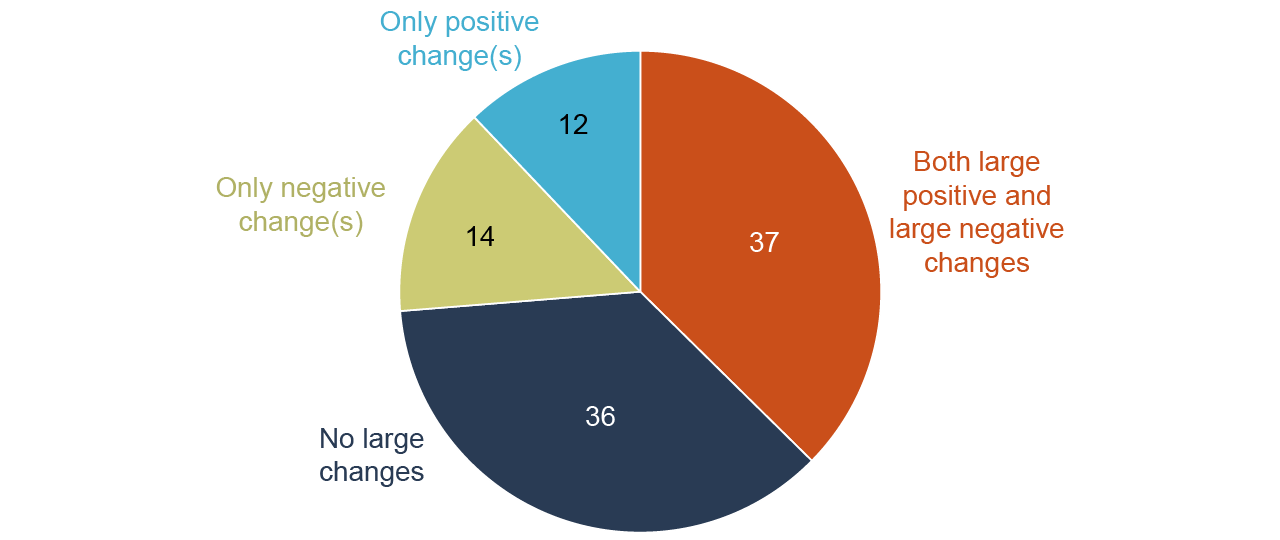Low-income Californians often face the dual challenge of having both low and unstable incomes. Income instability not only causes financial difficulties but is associated with a host of negative health and educational outcomes. Workers in agriculture, construction, service, and care sectors—fields in which Black and Latino workers are overrepresented—are especially vulnerable to income instability.
The social safety net can play a critical role in helping struggling residents stabilize their budgets. CalFresh, federally known as the Supplemental Nutrition Assistance program (SNAP), is one of California’s largest safety net programs. It provides food assistance to 4.8 million Californians and lifts about half a million Californians out of poverty, according to the most recent estimates. CalFresh plays an especially important role in economic downturns; during the COVID-19 crisis, increased benefits and a temporary postponement of required paperwork helped low-income families make ends meet.
Does CalFresh help stabilize family incomes?
CalFresh can mitigate earnings shocks for low-income families, but delays, changes, and interruptions in CalFresh benefits can also inadvertently destabilize incomes. Our analysis finds:
- Income instability is common among adults ages 25–54 accessing CalFresh. Nearly 4 in 10 experienced both large negative and positive shocks (25% or more) to their incomes in the year and a half before CalFresh enrollment.
- Though a third to half of adults accessing CalFresh spend at least one quarter without recorded income in the year prior to enrollment, a majority have at least one income source in the year after entry.
- For participants with current or recent employment, CalFresh stabilizes income by reducing drops in earnings. Adults who were new to CalFresh in the early months of the COVID-19 pandemic were especially likely to benefit from the program’s stabilizing role.
- Those without recent employment do not see the same stabilizing role of CalFresh benefits. Reaching these adults earlier could help stabilize and boost their incomes.
Large income swings are common before starting CalFresh

SOURCE: Author calculations from CDSS and EDD administrative data.
NOTES: Includes CalFresh entrants between January 2016 and June 2019. Changes are “large” if they are greater than 25 percent of own mean income over 12 quarters. Income includes earnings, CalFresh, CalWORKs, and Supplemental Security Income benefits.
How can policy better support CalFresh participants?
In sum, we do find evidence that about 45 percent of adults see a reduction in income instability due to CalFresh and other safety net benefits. At the same time, the majority see a large increase in income at entry followed by a large decrease at the six-month mark when income reporting is required. In part, this income instability is due to individuals acquiring any recorded source of income—a sobering reality for these low-income adults. CalFresh may be able to play a stabilizing role for these individuals if they can access the program closer to the point where they become eligible and maintain benefits for as long as they are eligible.
Connecting adults to CalFresh during times of employment or recent employment can help mitigate income instability in the long run. Outreach to individuals who have not yet connected with the program is challenging. However, further strengthening links between unemployment insurance and CalFresh could help.
The reporting burden is another source of income instability. Over a third of participants lose benefits after six months of CalFresh, when they must submit an income eligibility report. Participants without recent employment and single adults are especially likely to exit CalFresh at this point, despite, on average, not seeing their earnings rise, suggesting that they are still eligible. The fact that so many participants with the lowest incomes exit the program also indicates that the reporting burden is likely falling more heavily on those experiencing more disadvantage. Further efforts to automate income reporting would help reduce this drop-off and improve income stability. The pandemic pause in reassessing eligibility for enrolled participants could also be considered as a tool for the next economic downturn—in addition to bumping up benefits to help individuals and families meet basic needs.
As policymakers consider ways to strengthen the connections between safety net participation and economic mobility, a better understanding of the job and income instability participants face is critical. One important area for future research is the potential link between CalFresh participation and improved ties to the labor force and/or other safety net programs. Does CalFresh solely step in to boost incomes in the short run, or does it also act as a stepping stone to a more stable future? Additional research pinpointing the share and characteristics of low-income Californians who access CalFresh intermittently—as opposed to those who never access CalFresh—could also help refine strategies to increase the reach of the program.


